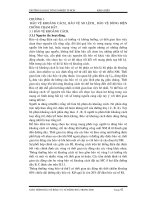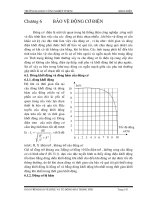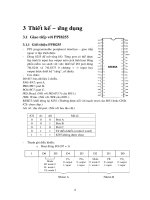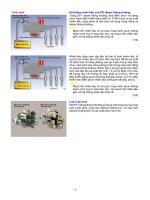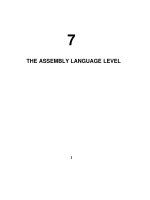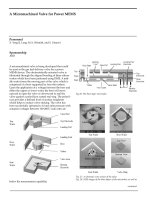Tài liệu POS-Tagger for English-Vietnamese Bilingual Corpus pdf
Bạn đang xem bản rút gọn của tài liệu. Xem và tải ngay bản đầy đủ của tài liệu tại đây (201.84 KB, 8 trang )
POS-Tagger for English-Vietnamese Bilingual Corpus
Dinh Dien
Information Technology Faculty of
Vietnam National University of HCMC,
20/C2 Hoang Hoa Tham, Ward 12,
Tan Binh Dist., HCM City, Vietnam
Hoang Kiem
Center of Information Technology
Development of
Vietnam National University of HCMC,
227 Nguyen Van Cu, District 5, HCM City,
Abstract
Corpus-based Natural Language Processing (NLP)
tasks for such popular languages as English, French,
etc. have been well studied with satisfactory
achievements. In contrast, corpus-based NLP tasks for
unpopular languages (e.g. Vietnamese) are at a
deadlock due to absence of annotated training data for
these languages. Furthermore, hand-annotation of even
reasonably well-determined features such as part-of-
speech (POS) tags has proved to be labor intensive and
costly. In this paper, we suggest a solution to partially
overcome the annotated resource shortage in
Vietnamese by building a POS-tagger for an
automatically word-aligned English-Vietnamese
parallel Corpus (named EVC). This POS-tagger made
use of the Transformation-Based Learning (or TBL)
method to bootstrap the POS-annotation results of the
English POS-tagger by exploiting the POS-information
of the corresponding Vietnamese words via their word-
alignments in EVC. Then, we directly project POS-
annotations from English side to Vietnamese via
available word alignments. This POS-annotated
Vietnamese corpus will be manually corrected to
become an annotated training data for Vietnamese NLP
tasks such as POS-tagger, Phrase-Chunker, Parser,
Word-Sense Disambiguator, etc.
1 Introduction
POS-tagging is assigning to each word of a text the
proper POS tag in its context of appearance. Although,
each word can be classified into various POS-tags, in a
defined context, it can only be attributed with a definite
POS. As an example, in this sentence: “I can can a
can”, the POS-tagger must be able to perform the
following: “I
PRO
can
AUX
can
V
a
DET
can
N
”.
In order to proceed with POS-tagging, such various
methods as Hidden Markov Models (HMM); Memory-
based models (Daelemans, 1996); Transformation-
based Learning (TBL) (Brill, 1995); Maximum
Entropy; decision trees (Schmid, 1994a); Neural
network (Schmid, 1994b); and so on can be used. In
which, the methods based on machine learning in
general and TBL in particular prove effective with
much popularity at present.
To achieve good results, the abovementioned
methods must be equipped with exactly annotated
training corpora. Such training corpora for popular
languages (e.g. English, French, etc.) are available (e.g.
Penn Tree Bank, SUSANNE, etc.). Unfortunately, so
far, there has been no such annotated training data
available for Vietnamese POS-taggers. Furthermore,
building manually annotated training data is very
expensive (for example, Penn Tree Bank was invested
over 1 million dollars and many person-years). To
overcome this drawback, this paper will present a
solution to indirectly build such an annotated training
corpus for Vietnamese by taking advantages of
available English-Vietnamese bilingual corpus named
EVC (Dinh Dien, 2001b). This EVC has been
automatically word-aligned (Dinh Dien et al., 2002a).
Our approach in this work is to use a bootstrapped
POS tagger for English to annotate the English side of
a word-aligned parallel corpus, then directly project the
tag annotations to the second language (Vietnamese)
via existing word-alignments (Yarowsky and Ngai,
2001). In this work, we made use of the TBL method
and SUSANNE training corpus to train our English
POS-tagger. The remains of this paper is as follows:
POS-Tagging by TBL method: introducing to
original TBL, improved fTBL, traditional English
POS-Tagger by TBL.
English-Vietnamese bilingual Corpus (EVC):
resources of EVC, word-alignment of EVC.
Bootstrapping English-POS-Tagger: bootstrapping
English POS-Tagger by the POS-tag of
corresponding Vietnamese words. Its evaluation
Projecting English POS-tag annotations to
Vietnamese side. Its evaluation.
Conclusion: conclusions, limitations and future
developments.
Edmonton, May-June 2003
Data Driven Machine Translation and Beyond , pp. 88-95
HLT-NAACL 2003 Workshop: Building and Using Parallel Texts
2 POS-Tagging by TBL method
The Transformation-Based Learning (or TBL) was
proposed by Eric Brill in 1993 in his doctoral
dissertation (Brill, 1993) on the foundation of structural
linguistics of Z.S.Harris. TBL has been applied with
success in various natural language processing (mainly
the tasks of classification). In 2001, Radu Florian and
Grace Ngai proposed the fast Transformation-Based
Learning (or fTBL) (Florian and Ngai, 2001a) to
improve the learning speed of TBL without affecting
the accuracy of the original algorithm.
The central idea of TBL is to start with some
simple (or sophisticated) solution to the problem (called
baseline tagging), and step-by-step apply optimal
transformation rules (which are extracted from a
annotated training corpus at each step) to improve
(change from incorrect tags into correct ones) the
problem. The algorithm stops when no more optimal
transformation rule is selected or data is exhausted. The
optimal transformation rule is the one which results in
the largest benefit (repairs incorrect tags into correct
tags as much as possible).
A striking particularity of TBL in comparison with
other learning methods is perceptive and symbolic: the
linguists are able to observe, intervene in all the
learning, implementing processes as well as the
intermediary and final results. Besides, TBL allows the
inheritance of the tagging results of another system
(considered as the baseline or initial tagging) with the
correction on that result based on the transformation
rules learned through the training period.
TBL is active in conformity with the
transformational rules in order to change wrong tags
into right ones. All these rules obey the templates
specified by human. In these templates, we need to
regulate the factors affecting the tagging. In order to
evaluate the optimal transformation rules, TBL needs
the annotated training corpus (the corpus to which the
correct tag has been attached, usually referred to as the
golden corpus) to compare the result of current tagging
to the correct tag in the training corpus. In the executing
period, these optimal rules will be used for tagging new
corpora (in conformity with the sorting order) and these
new corpora must also be assigned with the baseline
tags similar to that of the training period. These
linguistic annotation tags can be morphological ones
(sentence boundary, word boundary), POS tags,
syntactical tags (phrase chunker), sense tags,
grammatical relation tags, etc.
POS-tagging was the first application of TBL and
the most popular and extended to various languages
(e.g. Korean, Spanish, German, etc.) (Curran, 1999).
The approach of TBL POS-tagger is simple but
effective and it reaches the accuracy competitive with
other powerful POS-taggers. The TBL algorithm for
POS-tagger can be briefly described under two periods
as follows:
* The training period
:
Starting with the annotated training corpus (or
called golden corpus, which has been assigned
with correct POS tag annotations), TBL copies this
golden corpus into a new unannotated corpus
(called current corpus, which is removed POS tag
annotations).
TBL assigns an inital POS-tag to each word in
corpus. This initial tag is the most likely tag for a
word if the word is known and is guessed based
upon properties of the word if the word is not
known.
TBL applies each instance of each candidate rule
(following the format of templates designed by
human beings) in the current corpus. These rules
change the POS tags of words based upon the
contexts they appear in. TBL evaluates the result of
applying that candidate rule by comparing the
current result of POS-tag annotations with that of
the golden corpus in order to choose the best one
which has highest mark. These best rules are
repeatedly extracted until there is no more optimal
rule (its mark isn’t higher than a preset threshold).
These optimal rules create an ordered sequence.
* The executing period
:
Starting with the new unannotated text, TBL
assigns an inital POS-tag to each word in text in a
way similar to that of the training period.
The sequence of optimal rules (extracted from
training period) are applied, which change the POS
tag annotations based upon the contexts they
appear in. These rules are applied deterministically
in the order they appear in the sequence.
In addition to the above-mentioned TBL algorithm
that is applied in the supervised POS-tagger, Brill
(1997) also presented an unsupervised POS-tagger that
is trained on unannotated corpora. The accuracy of
unsupervised POS-tagger was reported lower than that
of supervised POS-tagger.
Because the goal of our work is to build a POS-tag
annotated training data for Vietnamese, we need an
annotated corpus with as high as possible accuracy. So,
we will concentrate on the supervised POS-tagger only.
For full details of TBL and FTBL, please refer to
Eric Brill (1993, 1995) and Radu Florian and Grace
Ngai (2001a).
3 English Vietnamese Bilingual Corpus
The bilingual corpus that needs POS-tagging in this
paper is named EVC (English Vietnamese Corpus).
This corpus is collected from many different resources
of bilingual texts (such as books, dictionaries, corpora,
etc.) in selected fields such as Science, Technology,
daily conversation (see table 1). After collecting
bilingual texts from different resources, this parallel
corpus has been normalized their form (text-only), tone
marks (diacritics), character code of Vietnam (TCVN-
3), character font (VN-Times), etc. Next, this corpus
has been sentence aligned and checked spell semi-
automatically. An example of unannotated EVC as the
following:
*D02:01323: Jet planes fly about nine miles high.
+D02:01323: Cỏc phi c phn lc bay cao khong
chớn dm.
Where, the codes at the beginning of each line refer
to the corresponding sentence in the EVC corpus. For
full details of building this EVC corpus (e.g. collecting,
normalizing, sentence alignment, spelling checker,
etc.), please refer to Dinh Dien (2001b).
Next, this bilingual corpus has been automatically
word aligned by a hybrid model combining the
semantic class-based model with the GIZA++ model.
An example of the word-alignment result is as in figure
1 below. The accuracy of word-alignment of this
parallel corpus has been reported approximately 87% in
(Dinh Dien et al., 2002b). For full details of word
alignment of this EVC corpus (precision, recall,
coverage, etc.), please refer to (Dinh Dien et al.,
2002a).
The result of this word-aligned parallel corpus has
been used in various Vietnamese NLP tasks, such as in
training the Vietnamese word segmenter (Dinh Dien et
al., 2001a), word sense disambiguation (Dinh Dien,
2002b), etc.
Remarkably, this EVC includes the SUSANNE
corpus (Sampson, 1995) a golden corpus has been
manually annotated such necessary English linguistic
annotations as lemma, POS tags, chunking tags,
syntactic trees, etc. This English corpus has been
translated into Vietnamese by English teachers of
Foreign Language Department of Vietnam University
of HCM City. In this paper, we will make use of this
valuable annotated corpus as the training corpus for our
bootstrapped English POS-tagger.
No. Resources The number
of pairs of
sentences
Number of
English
words
Number of
Vietnamese
morpho-words
Length
(English
words)
Percent
(words/
EVC)
1. Computer books 9,475 165,042 239,984 17.42 7.67
2. LLOCE dictionary 33,078 312,655 410,760 9.45 14.53
3. EV bilingual dictionaries 174,906 1,110,003 1,460,010 6.35 51.58
4. SUSANNE corpus 6,269 131,500 181,781 20.98 6.11
5. Electronics books 12,120 226,953 297,920 18.73 10.55
6. Childrens Encyclopedia 4,953 79,927 101,023 16.14 3.71
7. Other books 9,210 126,060 160,585 13.69 5.86
Total
250,011 2,152,140 2,852,063 8.59 100%
Table 1. Resources of EVC corpus
Figure 1. An example of a word-aligned pair of sentences in EVC corpus
Jet planes fly about nine miles
high
Caực phi cụ phaỷn lửùc bay cao khoaỷng chớn daởm
4 Our Bootstrapped English POS-Tagger
So far, existing POS-taggers for (mono-lingual)
English have been well developed with satisfactory
achievements and it is very difficult (it is nearly
impossible for us) to improve their results. Actually,
those existing advanced POS-taggers have exhaustively
exploited all linguistic information in English texts and
there is no way for us to improve English POS-tagger in
case of such a monolingual English texts. By contrast,
in the bilingual texts, we are able to make use of the
second language’s linguistic information in order to
improve the POS-tag annotations of the first language.
Our solution is motivated by I.Dagan, I.Alon and
S.Ulrike (1991); W.Gale, K.Church and D.Yarowsky
(1992). They proposed the use of bilingual corpora to
avoid hand-tagging of training data. Their premise is
that “different senses of a given word often translate
differently in another language (for example, pen in
English is stylo in French for its writing implement
sense, and enclos for its enclosure sense). By using a
parallel aligned corpus, the translation of each
occurrence of a word such as pen can be used to
automatically determine its sense”. This remark is not
only true for word sense but also for POS-tag and it is
more exact in such typologically different languages as
English vs. Vietnamese.
In fact, POS-tag annotations of English words as
well as Vietnamese words are often ambiguous but they
are not often exactly the same (table 4). For example,
“can” in English may be “Aux” for ability sense, “V”
for to make a container sense, and “N” for a container
sense and there is hardly existing POS-tagger which can
tag POS for that word “can” exactly in all different
contexts. Nevertheless, if that “can” in English is
already word-aligned with a corresponding Vietnamese
word, it will be POS-disambiguated easily by
Vietnamese word’ s POS-tags. For example, if “can” is
aligned with “có thể”, it must be Auxiliary ; if it is
aligned with “đóng hộp” then it must be a Verb
,
and if
it is aligned with “cái hộp” then it must be a Noun
.
However, not that all Vietnamese POS-tag
information is useful and deterministic.
The big
question here is when and how we make use of the
Vietnamese POS-tag information? Our answer is to
have this English POS-tagger trained by TBL method
(section 2) with the SUSANNE training corpus (section
3). After training, we will extract an ordered sequence
of optimal transformation rules. We will use these rules
to improve an existing English POS-tagger (as baseline
tagger) for tagging words of the English side in the
word-aligned EVC corpus. This English POS-tagging
result will be projected to Vietnamese side via word-
alignments in order to form a new Vietnamese training
corpus annotated with POS-tags.
4.1 The English POS-Tagger by TBL method
To make the presentation clearer, we re-use notations in
the introduction to fnTBL-toolkit of Radu Florian and
Grace Ngai (2001b) as follows:
• χ : denotes the space of samples: the set of words
which need POS-tagging. In English, it is simple to
recognize the word boundary, but in Vietnamese
(an isolate language), it is rather complicated.
Therefore, it has been presented in another work
(Dinh Dien, 2001a).
• C : set of possible POS-classifications c (or tagset).
For example: noun (N), verb (V), adjective (A), ...
For English, we made use of the Penn TreeBank
tagset and for Vietnamese tagset, we use the POS-
tagset mapping table (see appendix A).
• S = χxC: the space of states: the cross-product
between the sample space (word) and the
classification space (tagset), where each point is a
couple (word, tag).
•
π
: predicate defined on S
+
space, which is on a
sequence of states. Predicate
π
follows the
specified templates of transformation rules. In the
POS-tagger for English, this predicate only
consists of English factors which affect the POS-
tagging process, for example
U
],[ nmi
i
Word
+−∈∃
or
U
],[ nmi
i
Tag
+−∈∃
or
U
],[ nmi
ji
TagWord
+−∈∃
∧
.
Where, Word
i
is the morphology of the i
th
word from
the current word. Positive values of i mean
preceding (its left side), and negative ones mean
following (its right side). i ranges within the
window from –m to +n. In this English-
Vietnamese bilingual POS-tagger, we add new
elements including
0
VTag
and
0
VTag∃
to those
predicates. VTag
0
is the Vietnamese POS-tag
corresponding to the current English word via its
word-alignment. These Vietnamese POS-tags are
determined by the most frequent tag according to
the Vietnamese dictionary.
• A rule r defined as a couple (
π
, c) which consists
of predicate
π
and tag c. Rule r is written in the
form
π
⇒ c. This means that the rule r = (
π
, c) will
be applied on the sample x if the predicate
π
is
satisfied on it, whereat, x will be changed into a
new tag c.
• Giving a state s = (x,c) and rule r = (
π
, c), then the
result state r(s), which is gained by applying rule r
on s, is defined as:
s if
π
(s)=False
(x, c’) if
π
(s)=True
r(s) =
• T : set of training samples, which were assigned
correct tag. Here we made use of the SUSANNE
golden corpus (Sampson, 1995) whose POS-tagset
was converted into the PTB tagset.
• The score associated with a rule r = (
π
, c) is usually
the difference in performance (on the training data)
that results from applying the rule, as follows:
∑∑
∈∈
−=
TsTs
sscoresrscorerScore )())(()(
4.2 The TBL algorithm for POS-Tagging
The TBL algorithm for POS-tagging can be briefly
described as follows (see the flowchart in figure 2):
Step 1
: Baseline tagging: To initiatize for each sample x
in SUSANNE training data with its most likely POS-tag
c. For English, we made use of the available English
tagger (and parser) of Eugene Charniak (1997) at
Brown University (version 2001). For Vietnamese, it is
the set of possible parts-of-speech tags (follow the
appearance probability order of that part-of-speech in
dictionary). We call the starting training data as T
0
.
Step 2
: Considering all the transformations (rules) r to
the training data T
k
in time k
th
, choose the one with the
highest Score(r) and applying it to the training data to
obtain new corpus T
k+1
. We have: T
k+1
= r(T
k
) = { r(s) |
s∈T
k
}. If there are no more possible transformation
rules which satisfies: Score(r) >
β
, the algorithm is
stopped.
β
is the threshold, which is preset and adjusted
according to reality situations.
Step 3
: k = k+1.
Step 4
: Repeat from step 2.
Step 5
: Applying every rule r which is drawn in order
for new corpus EVC after this corpus has been POS-
tagged with baseline tags similar to those of the training
period.
* Convergence ability of the algorithm
: call e
k
the
number of error (the difference between the tagging
result in conformity with rule r and the correct tag in
the golden corpus in time k
th
), we have: e
k+1
= e
k
–
Score(r), since Score(r) > 0, so e
k+1
< e
k
with all k, and
e
k
∈N, so the algorithm will be converged after limited
steps.
* Complexity of the algorithm
: O(n*t*c) where n: size
of training set (number of words); t: size of possible
transformation rule set (number of candidate rules); c:
size of corpus satisfied rule applying condition (number
of order satisfied predicate π).
4.3 Experiment and Results of Bootstrapped
English POS-Tagger
After the training period, this system will extract an
ordered sequence of optimal transformation rules under
following format, for examples:
VBtagNNtagTOtag ←⇒=∧=
− 001
))()((
MDtagVBtagMDVTagcanWord ←⇒=∧=∧=
0000
))()()""((
VBtagVPBtagMDTagi
i
←⇒=∧=−−∈∃
00
))()|]1,3[((
These are intuitive rules and easy to understand by
human beings. For examples: the 2
nd
rule will be
understood as follows: “if the POS-tag of current word
is VB (Verb) and its word-form is “can” and its
corresponding Vietnamese word-tag is MD (Modal),
then the POS-tag of current word will be changed into
MD”.
We have experimented this method on EVC corps
with the training SUSANNE corpus. To evaluate this
method, we held-back 6,000-word part of the training
corpus (which have not been used in the training
period) and we achieved the POS-tagging results as
follows:
Step Correct
tags
Incorrect
Tags
Precision
Baseline tagging
(Brown POS-tagger)
5724 276 95.4%
TBL-POS-tagger
(bootstrapping by
corresponding
Vietnamese POS-tag)
5850 150 97.5%
Table 2. The result of Bootstrapped POS-
tagger for English side in EVC.
It is thanks to exploiting the information of the
corresponding Vietnamese POS that the English POS-
tagging results are improved. If we use only available
English information, it is very difficult for us to
improve the output of Brown POS-tagger. Despite the
POS-tagging improvement, the results can hardly said
to be fully satisfactory due to the following reasons:
* The result of automatic word-alignment is only
87% (Dinh Dien et al., 2002a).
* It is not always true that the use of Vietnamese
POS-information is effective enough to disambiguate
the POS of English words (please refer to table 3).
Through the statistical table 3 below, the
information of Vietnamese POS-tags can be seen as
follows:
- Case 1,2,3,4: no need for any disambiguation of
English POS-tags.
- Case 5, 7: Full disambiguation of English POS-tags
(majority).
- Case 6, 8, 9: Partial disambiguation of English
POS-tags by TBL-method.
1 if c = True(x)
0 if c ≠ True(x)
score((x,c)) =
